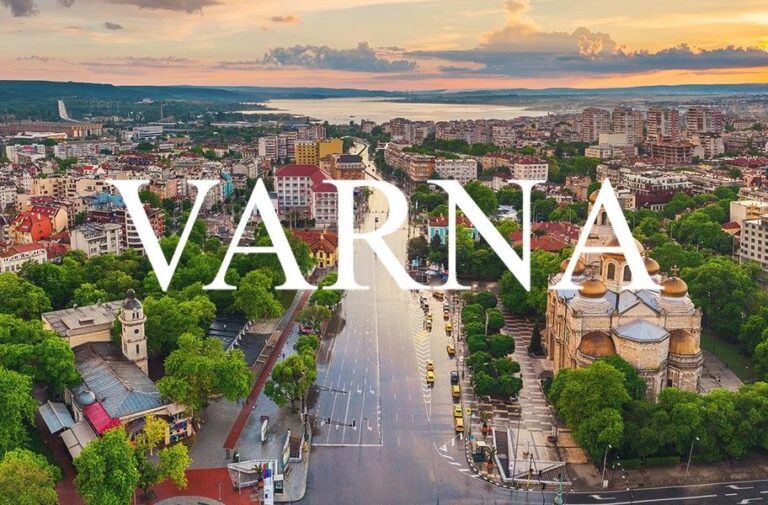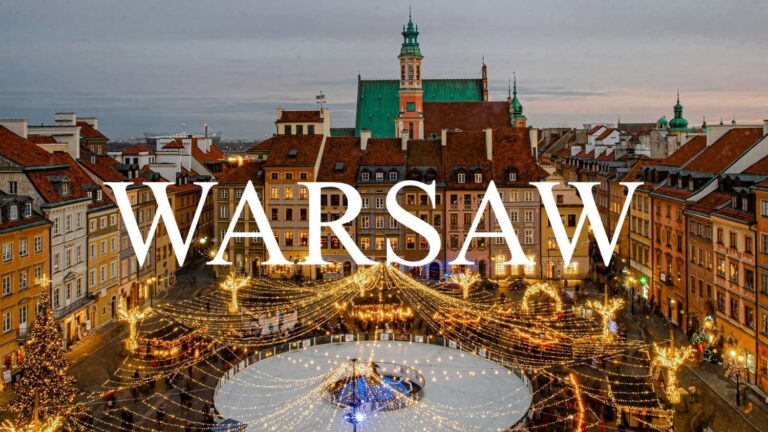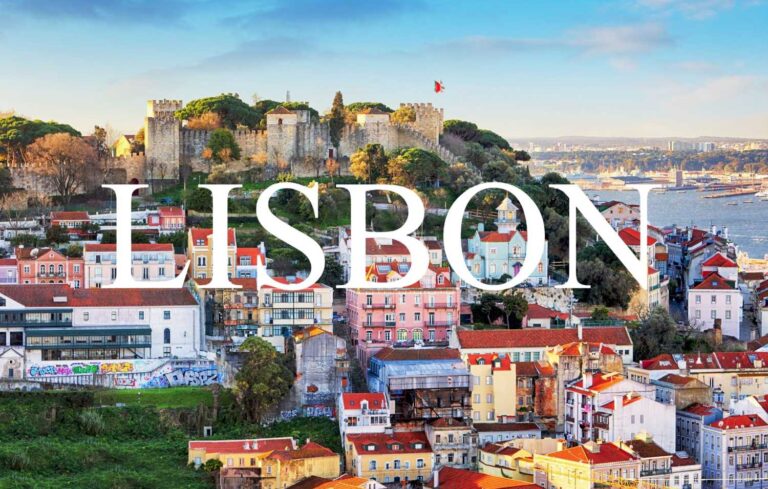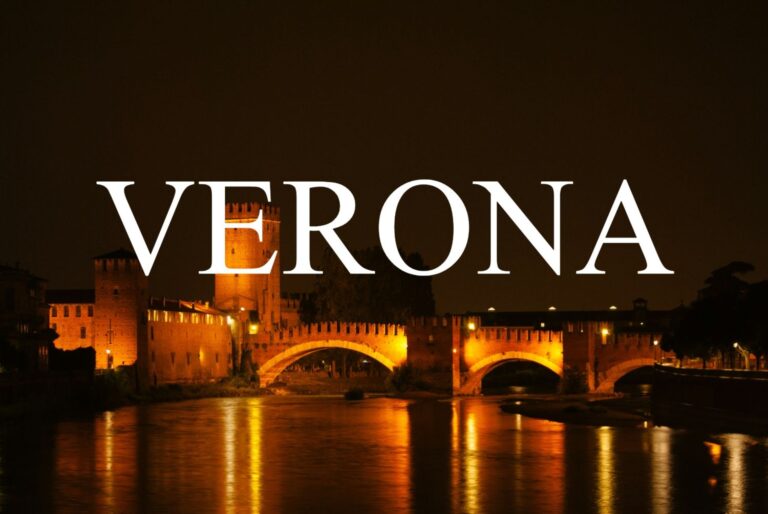
Budapest, often affectionately known as the “Pearl of the Danube”, is one of Europe’s most enchanting cities — a vibrant metropolis where old-world charm meets contemporary energy. Divided by the majestic Danube River into the historic hills of Buda and the dynamic plains of Pest, Budapest is a city of contrasts that effortlessly blends Eastern and Western influences. It’s a destination where medieval castles, neo-Gothic landmarks, and Ottoman-era thermal baths stand alongside trendy cafés, ruin pubs, and modern design boutiques.
As you explore the city, you’ll find layers of history woven into every street and square — from the grandeur of the Hungarian Parliament Building to the timeless beauty of Buda Castle and the sweeping views from Fisherman’s Bastion. Budapest’s famous thermal baths, like Széchenyi and Gellért, offer not only relaxation but a peek into the city’s centuries-old spa culture. At night, the city transforms — with atmospheric riverside walks, illuminated bridges, and a buzzing nightlife scene that ranges from rooftop bars to underground music venues.
Whether you’re marveling at Art Nouveau architecture, sampling local Hungarian dishes like goulash and chimney cake, or cruising down the Danube at sunset, Budapest offers something for every kind of traveler. It’s a haven for history enthusiasts, foodies, photographers, and culture lovers alike.
In this guide, we’ll walk you through the best places to visit in Budapest, offer tips on the ideal time to go, and provide insider advice to help you make the most of your journey through this unforgettable Central European capital.
Best Places to Visit in Budapest
Buda Castle and Castle Hill

Photo by Henrique Ferreira on Unsplash
Rising high on the Castle Hill, overlooking the Danube River, Buda Castle is one of Budapest’s most iconic landmarks and a UNESCO World Heritage Site. With its royal history, stunning architecture, and panoramic views of the city, Buda Castle is an essential part of any visit to Hungary’s capital. The castle complex, which includes the Royal Palace, Fisherman’s Bastion, and numerous museums, offers a deep dive into the rich cultural and political history of Budapest and Hungary. Whether you’re a history enthusiast, an architecture lover, or simply someone seeking breathtaking views, Buda Castle and Castle Hill offer an unforgettable experience.
🌟 Highlights of Buda Castle and Castle Hill
• 🏰 Buda Castle (Royal Palace)
The Buda Castle has been the seat of Hungarian kings since the 13th century. Over the centuries, it has been expanded and rebuilt several times, resulting in a fascinating blend of architectural styles, from Gothic to Baroque. Today, the castle houses the Hungarian National Gallery, the Budapest History Museum, and the National Széchényi Library, making it a hub for Hungarian art, history, and culture. The changing of the guard ceremony at the castle’s gates is a popular event for visitors.
• 🎨 Hungarian National Gallery
Inside Buda Castle, the Hungarian National Gallery offers an incredible collection of Hungarian art, from medieval religious paintings to contemporary works. Visitors can admire the masterpieces of renowned Hungarian artists, including István Szentgyörgyi and László Paál, along with international pieces that showcase Hungary’s artistic influence. The museum is a must-visit for art lovers looking to explore Hungary’s rich cultural heritage.
• 🏰 Royal Garden and Courtyards –
Wander through the Royal Garden and the picturesque courtyards surrounding Buda Castle, where you can relax and enjoy the tranquil atmosphere. The Courtyard of the Royal Palace is particularly impressive, with its statues, fountains, and beautiful views. You’ll also find the Matthias Fountain in the courtyard, which is adorned with stunning sculptures and makes for a fantastic photo opportunity.
• 🏞️ Fisherman’s Bastion
Located just a short walk from Buda Castle, the Fisherman’s Bastion is one of Budapest’s most recognizable landmarks. This stunning lookout terrace offers panoramic views of the Danube, Pest, and the Parliament Building. The bastion’s fairy-tale-like towers and terraces are perfect for photos, and the whole area exudes a charming, almost magical atmosphere. While it was built in the early 20th century, it is named after the fishermen who once defended the castle walls in the Middle Ages.
• ⛪ Matthias Church (Church of Our Lady of Buda)
Situated next to Fisherman’s Bastion, Matthias Church is one of Budapest’s most important religious sites. With its stunning Gothic architecture, intricately painted interiors, and colorful tiled roof, the church is a visual masterpiece. It has witnessed many royal coronations throughout history and is home to important religious artifacts, including medieval paintings and the Holy Crown of Hungary. The church’s history, combined with its beauty, makes it an essential stop during your visit to Castle Hill.
• 🏛️ Budapest History Museum
Located inside Buda Castle, the Budapest History Museum provides an in-depth look at the city’s evolution. From the early Roman settlement of Aquincum to the medieval Buda Castle, visitors can explore archaeological exhibits, artifacts, and interactive displays that trace the city’s growth. It’s a great place for history buffs looking to understand the layers of culture that make Budapest so unique.
🚶 How to Get There
• By Funicular:
One of the most popular ways to reach Castle Hill is by taking the Budavári Sikló, a historic funicular railway that connects Clark Ádám Square at the base of the hill to the top, near Buda Castle. The ride offers a quick, scenic ascent, providing stunning views of the city as you climb.
• By Bus or Car:
You can reach Buda Castle by bus (lines 16, 16A) from Széll Kálmán tér or from Batthyány tér. There are also parking areas around the castle complex, though they can get crowded during peak tourist hours.
• On Foot:
If you prefer to walk, you can reach Castle Hill via the winding, cobbled streets of the Várnegyed district. It’s a bit of a steep climb, but the views along the way are well worth it. You’ll pass charming, narrow streets and historic buildings, making the walk a pleasant experience.
🕒 Visitor Information
• Opening Hours:
- Buda Castle: Open daily from 9:00 AM to 6:00 PM. Some museums inside the castle may have different hours, so it’s best to check their websites for specific opening times.
- Fisherman’s Bastion: Open daily, though there may be restricted access to certain areas during religious ceremonies or special events.
- Matthias Church: Typically open from 9:00 AM to 5:00 PM for visitors. Mass services are held on Sundays.
• Estimated Duration:
To explore the entire Buda Castle complex, including museums, courtyards, and Fisherman’s Bastion, allow 3–4 hours. If you’re also visiting Matthias Church and the History Museum, you might want to allocate half a day.
💡 Travel Tips
• 🕰️ Best Time to Visit:
The best time to visit Buda Castle and Castle Hill is during the spring and autumn months, when the weather is mild, and the crowds are thinner. The area is especially beautiful at sunset, with the sun casting a golden glow over the Danube and the Parliament Building.
• 📸 What to Bring:
Comfortable walking shoes are essential, as the cobbled streets can be uneven. Bring a camera to capture the panoramic views from Fisherman’s Bastion, especially at sunset. Don’t forget sunscreen, a hat, and a bottle of water, especially if you’re visiting in the summer.
• 🧭 Guided Tours:
If you’re interested in learning more about the history of Buda Castle and the surrounding area, consider joining a guided tour. Many tours include a visit to the castle, Matthias Church, and Fisherman’s Bastion, providing in-depth commentary on the area’s fascinating past.
Buda Castle and Castle Hill are the crown jewels of Budapest. From the Royal Palace and Fisherman’s Bastion to the Matthias Church, the area offers a wealth of history, culture, and stunning views that will leave you in awe. Whether you’re gazing at the Danube from the top of Castle Hill or exploring the museums and courtyards of the castle, this part of Budapest is a true cultural treasure. Don’t miss it—it’s a must-see for anyone visiting the Hungarian capital!
Parliament Building
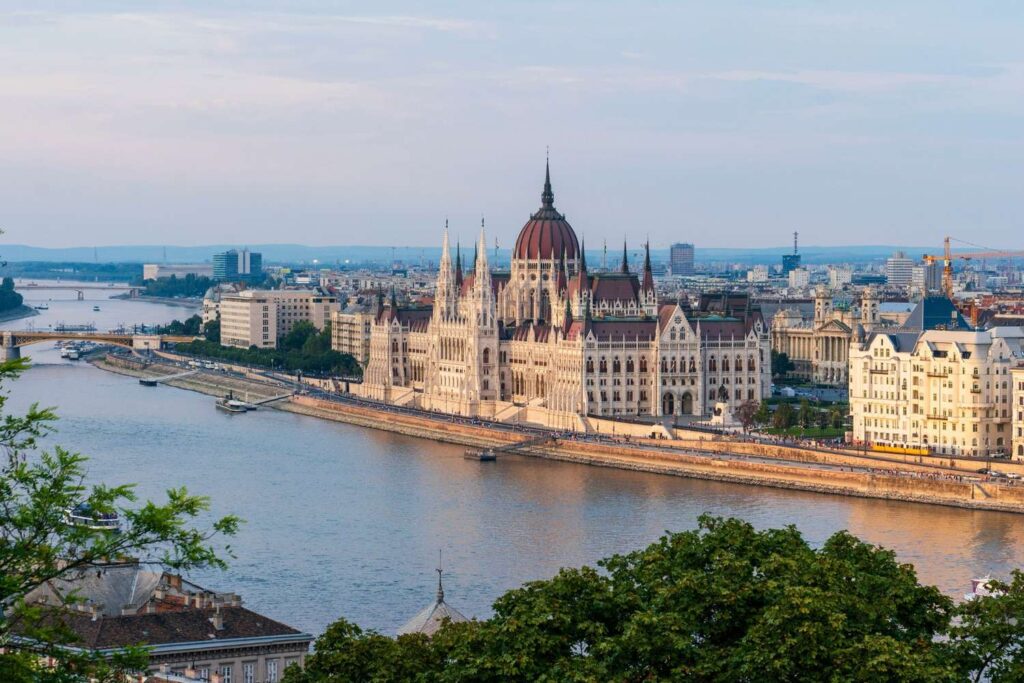
Photo by Ervin Lukacs on Unsplash
One of the most stunning landmarks in Budapest, the Hungarian Parliament Building (Országház) is a true architectural masterpiece that commands attention from across the Danube River. Located on the Pest side of the city, this grand structure is the largest building in Hungary and one of the most beautiful parliamentary buildings in the world. With its striking Gothic Revival style, ornate facades, and rich history, the Parliament Building stands as a symbol of Hungary’s democratic heritage, making it an absolute must-visit when in Budapest.
🌟 Highlights of the Hungarian Parliament Building
• 🏰 Architectural Grandeur
Designed by architect Imre Steindl and completed in 1904, the Parliament Building is a stunning example of Gothic Revival architecture, combined with elements of Renaissance Revival and Baroque styles. The building’s iconic façade features intricate carvings, spires, and statues, with a central dome that rises 96 meters (315 feet) into the sky, symbolizing the year 896 when the Hungarian state was founded. The building is neoclassical, and its design reflects Hungary’s rich historical and cultural legacy.
• 🏛️ The Dome Hall
The Dome Hall is the most stunning part of the Parliament, with its soaring dome, beautifully painted ceiling, and intricately detailed statues and pillars. This hall houses the Holy Crown of Hungary, one of the most important symbols of the Hungarian state. The crown is displayed inside a glass case, and it is said to have magical powers that protect the nation.
• 🎨 Interior Decorations
Inside the Parliament, visitors are treated to luxurious decor and stunning artworks. The Grand Staircase is adorned with marble columns and gold accents, leading to several chambers. The National Assembly Hall, where Hungary’s legislative assembly meets, is equally impressive with its rich tapestries and gilded details. Stained glass windows and intricate woodwork enhance the grandeur of the Parliament, making it a feast for the eyes.
• 🏛️ Guided Tours
Visitors can take guided tours of the Parliament Building to learn more about its history, architecture, and the political life of Hungary. During these tours, you’ll visit the Dome Hall, National Assembly Hall, and other important chambers where Hungary’s laws are discussed and passed. The knowledgeable guides will provide insights into the building’s construction, cultural significance, and its role in modern Hungarian democracy.
• 🌟 The Statue of the Unknown Soldier
In front of the Parliament Building lies the statue of the Unknown Soldier, a powerful tribute to those who gave their lives in defense of Hungary. The memorial is located near the Parliament’s main entrance and is a place for reflection and respect. It is often a site for ceremonial events and military honors.
🚶 How to Get There
• By Foot:
The Parliament Building is located in central Pest, making it easily accessible by foot from many nearby attractions, including Váci Street and St. Stephen’s Basilica. Walking along the Danube promenade offers scenic views of the building and is an excellent way to approach the site.
• By Public Transport:
- Metro: Take the M2 (Red Line) to Kossuth Lajos tér station, which is right next to the Parliament Building.
- Tram: Tram lines 2 and 4 also stop nearby. The Tram 2 line runs along the Danube River, providing beautiful views of the Parliament on your journey.
- Bus: Bus lines 15, 115, and 79 stop at Kossuth Lajos tér.
• By Boat:
Another fantastic way to experience the Parliament Building is by taking a Danube River cruise. Many cruises depart from downtown Pest and pass by the Parliament, allowing you to see the building from the water—especially stunning at night when it’s illuminated.
🕒 Visitor Information
• Opening Hours:
- Guided Tours: Tours of the Parliament Building are available daily except for national holidays and during government events. The opening hours are generally from 8:00 AM to 6:00 PM, though times may vary, so it’s advisable to check in advance.
- Parliamentary Sessions: If you wish to attend a parliamentary session, you can request tickets for a public debate. However, the Parliament is closed to tourists during these sessions.
• Estimated Duration:
- A guided tour of the Parliament Building typically lasts 45 minutes to 1 hour. However, if you plan to explore the surrounding area, photograph the building, or attend a session, you should allow 2 to 3 hours for your visit.
💡 Travel Tips
• 🕰️ Best Time to Visit:
The best time to visit the Parliament Building is early in the morning to avoid crowds, especially if you’re interested in joining a guided tour. The building is also beautifully lit up in the evenings, making it a fantastic photo opportunity at sunset or after dark.
• 📸 What to Bring:
Don’t forget your camera to capture the grand architecture and sweeping views of the Danube and Chain Bridge. Comfortable walking shoes are also a must, especially if you’re walking around the Parliament complex or nearby attractions.
• 🎧 Audio Guides:
If you’re not interested in a guided tour, consider using an audio guide. It’s available in several languages and offers insights into the history and design of the building, allowing you to explore at your own pace.
The Hungarian Parliament Building is not just an architectural gem; it’s a symbol of Hungary’s proud history, culture, and democratic values. Whether you’re admiring the stunning design from the outside or exploring its magnificent interiors, a visit to this landmark is an unforgettable experience. With its rich historical significance, breathtaking views, and incredible craftsmanship, the Parliament Building is a must-see when visiting Budapest—an essential stop on your journey through the heart of Hungary’s capital.
Széchenyi Thermal Baths
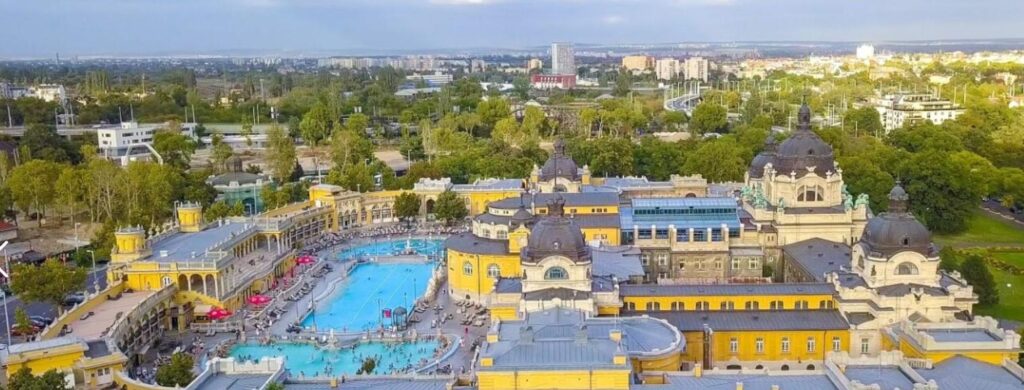
Located in the lush City Park (Városliget), Széchenyi Thermal Baths is one of the largest and most iconic thermal bath complexes in Europe. Known for its stunning neo-Baroque architecture, hot spring pools, and rejuvenating atmosphere, Széchenyi offers a uniquely Hungarian experience that’s perfect for relaxation and wellness. Whether you’re soaking in the outdoor pools while surrounded by steam or indulging in a traditional massage, this historical bathhouse provides a serene escape from the hustle and bustle of the city. A visit to Széchenyi is more than just a dip in the water—it’s a cultural experience that connects you to Budapest’s centuries-old thermal bath tradition.
🌟 Highlights of Széchenyi Thermal Baths
• 🌊 Outdoor Thermal Pools
Széchenyi’s outdoor pools are the main attraction. In winter, the hot water creates a magical mist that contrasts with the cold air, making it feel like a surreal experience. In summer, the large outdoor thermal pools are ideal for lounging, chatting with friends, or simply enjoying the sunshine. The warm water, rich in minerals, is not only relaxing but also believed to have therapeutic properties.
• 🏰 Beautiful Neo-Baroque Architecture
The Széchenyi Baths are housed in an impressive neo-Baroque building, built in the early 20th century. The architecture itself is a reason to visit—its elaborate façade, stunning columns, and grand entrance make it one of the most beautiful bathhouses in Europe. The building’s mosaics, stained glass windows, and intricate details create a regal, historical atmosphere that enhances the overall experience.
• 🧖♀️ Indoor Thermal Pools
Inside Széchenyi, there are several thermal pools of varying temperatures, ranging from 18°C to 40°C (64°F to 104°F). These pools are rich in minerals like calcium, magnesium, and sodium, believed to promote circulation, relieve muscle pain, and improve skin health. The indoor areas also feature steam rooms and saunas, ideal for detoxifying the body and relaxing your mind.
• 💆♂️ Wellness and Spa Services
Széchenyi offers a variety of spa treatments and massages for those looking to enhance their wellness experience. Aromatic massages, mud wraps, and aromatherapy treatments are available for a truly rejuvenating experience. Pedicures, manicures, and beauty services are also offered for those looking for pampering.
• 🚶♀️ Chess in the Water
Széchenyi is famous for its chess-playing tradition. Local residents often play chess on floating boards in the outdoor thermal pools, making it a unique experience for visitors to witness. If you’re into chess, why not join in the fun and challenge a local to a game while soaking in the warm water?
• 🧘♂️ Relaxation and Tranquility
The Széchenyi Baths offer a peaceful escape, providing a calm and soothing environment where you can unwind. Whether you’re there for a quick dip or planning to spend several hours, the serene ambiance allows you to forget the noise and fast pace of the city.
🚶 How to Get There
• By Foot:
Széchenyi Thermal Baths is located in City Park, about a 15-minute walk from Heroes’ Square and the Vajdahunyad Castle. You can enjoy a scenic walk through City Park as you approach the baths, making it a pleasant route.
• By Metro:
The M1 Metro line (yellow line) has a station at Széchenyi fürdő, which is located directly next to the baths. This makes it an easy and quick route if you’re traveling from downtown Budapest.
• By Bus or Tram:
The bus lines 72, 75, 79 and tram line 1 stop at or near Széchenyi Thermal Baths, making it easily accessible from other parts of the city.
🕒 Visitor Information
• Opening Hours:
- Daily: 6:00 AM to 10:00 PM
- Important: The baths may close earlier for maintenance or during holidays, so it’s advisable to check their website in advance, especially during busy times.
• Estimated Duration:
- A typical visit to Széchenyi lasts between 2–4 hours, depending on how long you want to relax and explore the different pools and treatments. If you’re planning to get a massage or spa treatment, you might want to allow for an extra hour or two.
💡 Travel Tips
• 🕰️ Best Time to Visit:
- The best time to visit Széchenyi is early in the morning or late in the evening to avoid the crowds. Visiting during the winter months adds to the experience, as the contrast between the steaming hot water and the crisp air creates a magical atmosphere.
- Summer can get crowded, especially during weekends, so visiting on a weekday or in the off-season will give you a more relaxed experience.
• 📸 What to Bring:
- Swimwear: Make sure to bring appropriate swimwear—only swimming trunks, bikinis, or one-piece swimsuits are allowed.
- Flip-flops: The floor around the pools can get slippery, so flip-flops or water shoes are recommended.
- Towel and Locker: You can rent a towel and a locker at the baths, but if you prefer to bring your own, that’s also fine.
• 🧴 Hydrate and Protect Yourself:
Make sure to drink plenty of water during your visit, as the hot pools can be dehydrating. Sunscreen is also recommended for those visiting the outdoor pools, especially during summer.
• 👙 What’s Not Allowed:
- Towels and bathrobes are not allowed in the pools. Towels should only be used when leaving the water.
- Eating and drinking are not allowed in the pools to maintain cleanliness and safety.
Széchenyi Thermal Baths is more than just a place to bathe—it’s an experience that combines relaxation, culture, and history. Whether you’re immersing yourself in the healing thermal waters, enjoying a traditional massage, or simply taking in the stunning architecture, the Széchenyi Baths is a rejuvenating retreat in the heart of Budapest. This iconic wellness center offers a unique way to experience Hungarian culture, making it an essential stop on your Budapest itinerary. Whether you’re visiting for relaxation or fun, Széchenyi provides a timeless and restorative experience that will stay with you long after you leave.
St. Stephen’s Basilica
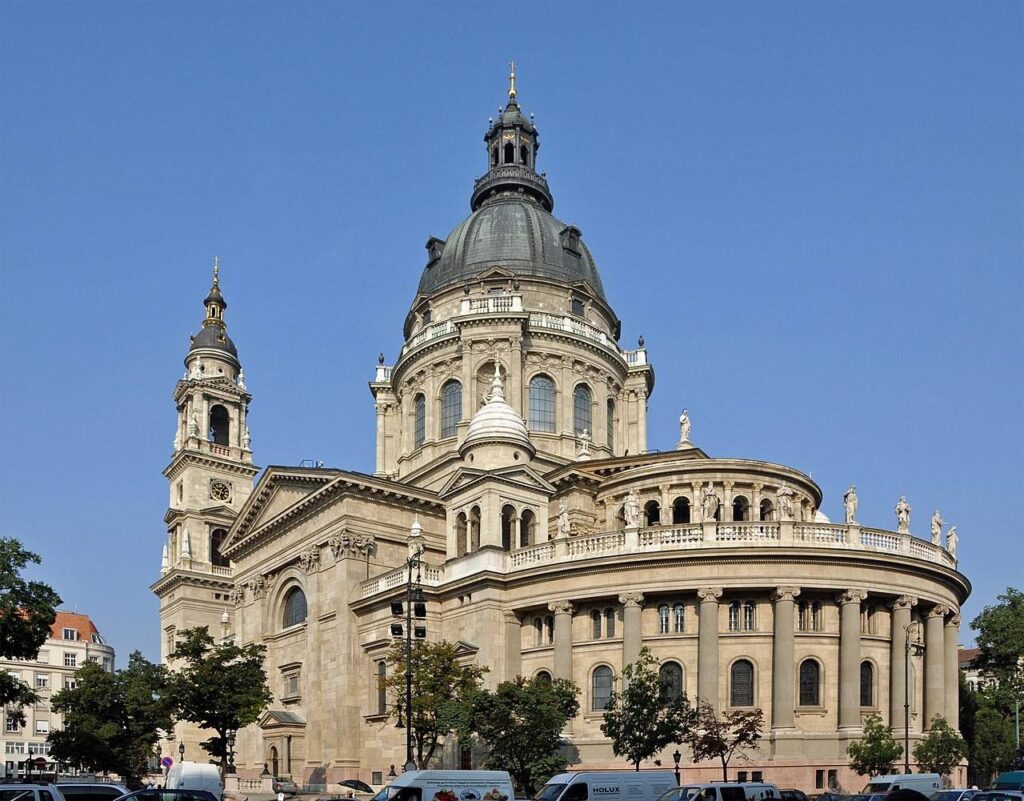
One of the most prominent landmarks in Budapest, St. Stephen’s Basilica (Szent István Bazilika) is a grand and awe-inspiring symbol of Hungary’s spiritual and architectural heritage. Located in the heart of the city, this neoclassical church is not only a place of worship but also an architectural marvel that attracts thousands of visitors each year. Named in honor of King Stephen I, the first King of Hungary, it stands as a testament to the nation’s deep Catholic roots and its rich history. The basilica’s stunning design, grand interiors, and panoramic views from the dome make it an essential stop for anyone visiting Budapest.
🌟 Highlights of St. Stephen’s Basilica
• 🏛️ Architectural Grandeur
Designed by architect József Hild and completed in 1905, St. Stephen’s Basilica is a beautiful blend of neoclassical and baroque styles. Its stunning façade is dominated by a massive dome that rises 96 meters (315 feet) high, symbolizing the 96 years of King Stephen I’s reign. The facade is adorned with grand statues of saints, while the interior features marble columns, intricate frescoes, and impressive altars.
• 🏛️ The Dome
The highlight of St. Stephen’s Basilica is its dome, which offers a breathtaking panoramic view of the city. Visitors can climb to the top of the dome for sweeping views of Budapest’s skyline, including the Danube River, Parliament Building, Buda Castle, and the Chain Bridge. The panoramic view is especially spectacular at sunrise or sunset, when the city is bathed in soft light.
• 🎨 Interior Splendor
Inside, the basilica is a feast for the eyes. The main altar, which houses a relic of St. Stephen, is intricately designed with gold accents and impressive statuary. The church’s stained glass windows cast colorful light into the interior, creating a warm and reverent atmosphere. Frescoes depicting biblical scenes adorn the ceilings, while the aisles are lined with grand marble pillars and statues of saints, creating a sense of awe and tranquility.
• 💫 The Holy Right Hand of St. Stephen
One of the most significant features of the basilica is the Holy Right Hand of St. Stephen, which is preserved in a special chapel on the right side of the altar. This relic, believed to be the actual right hand of Hungary’s first king, is displayed for public viewing during certain times of the year, offering a direct connection to Hungary’s royal past and Christian heritage.
• 🎶 Sacred Concerts and Music
St. Stephen’s Basilica is not only a place of worship but also a venue for sacred music and classical concerts. Throughout the year, the basilica hosts organ recitals, choir performances, and classical music concerts, creating a serene environment where music lovers can enjoy stunning acoustics within a truly majestic setting.
🚶 How to Get There
• By Foot:
St. Stephen’s Basilica is centrally located, making it easily accessible by foot from other famous Budapest landmarks. It’s just a 5-minute walk from Andrássy Avenue, and a short stroll from Deák Ferenc Square, where major metro lines intersect.
• By Metro:
The basilica is located near the Deák Ferenc tér metro station, which is a major interchange station for Lines 1 (yellow), 2 (red), and 3 (blue). The M2 (red line) stops closest to the basilica at St. Stephen’s Basilica station (Szent István Bazilika).
• By Bus/Tram:
Several buses and trams stop near St. Stephen’s Basilica, including bus 105, tram 47, and tram 49, all of which have stops at or near Bajcsy-Zsilinszky Út, just a few minutes’ walk from the church.
🕒 Visitor Information
• Opening Hours:
- Daily: Open for visits from 9:00 AM to 5:00 PM, with mass services held regularly throughout the day.
- Mass Times: Masses are celebrated at 6:00 PM (weekday) and 11:00 AM (Sunday), and visitors are welcome to attend.
• Estimated Duration:
- A typical visit lasts around 45 minutes to 1 hour if you’re just exploring the interior and the dome. If you’re attending a concert or taking a more leisurely stroll through the basilica, you can plan for 1–2 hours.
💡 Travel Tips
• 🕰️ Best Time to Visit:
- Morning or late afternoon is the best time to visit for a quieter experience. Avoid weekends or holidays when the basilica can get crowded, especially during mass services.
- For the best panoramic views, consider visiting the dome at sunset, when the city’s landmarks are beautifully bathed in golden light.
• 📸 What to Bring:
- Comfortable shoes are recommended if you plan to climb to the top of the dome. The stairs can be steep, but the view is worth it!
- Camera: Don’t forget your camera for both the stunning views from the dome and the magnificent details inside the basilica.
• 👗 Dress Code:
- As St. Stephen’s Basilica is an active place of worship, visitors are asked to dress respectfully. Shoulders and knees should be covered when entering, and hats should be removed as a sign of respect.
• 🧑🤝🧑 Group Visits:
For group visits, it’s advisable to book in advance. The basilica offers guided tours for a more detailed insight into the history, art, and significance of the site.
St. Stephen’s Basilica is more than just a church—it’s a symbol of Hungary’s deep-rooted Catholic faith, a masterpiece of architecture, and a cultural hub in the heart of Budapest. With its awe-inspiring dome, intricate interiors, and panoramic views, it offers a serene and uplifting experience that captivates all who visit. Whether you’re admiring the stunning architecture, soaking in the city’s skyline from the dome, or attending a concert in the sacred space, St. Stephen’s Basilica is an unforgettable part of the Budapest experience. A visit here is an essential and enriching part of exploring this magnificent city.
The Great Market Hall (Nagy Vásárcsarnok)
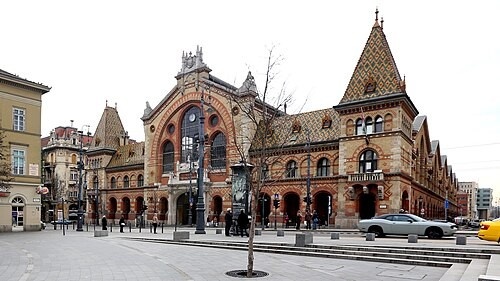
Located at the end of Váci Street and near the Liberty Bridge, The Great Market Hall (Nagy Vásárcsarnok) is Budapest’s largest and oldest indoor market, offering an authentic slice of Hungarian life. Built in 1897, this historic market building is not just a place to shop but also a lively, colorful destination where local culture, cuisine, and commerce collide. With its towering iron-frame structure, colorful ceramic tiles, and aromatic stalls, the market is a must-visit for food lovers, tourists, and anyone seeking an authentic Hungarian experience. Whether you’re there for fresh produce, Hungarian sausages, or souvenirs, the market provides an energetic atmosphere that reflects the true spirit of Budapest.
🌟 Highlights of The Great Market Hall
• 🥘 Hungarian Culinary Delights
One of the market’s most exciting features is its food stalls, offering a wide variety of Hungarian specialties. You can sample goulash, langos (deep-fried flatbread), paprika, and pickled vegetables, or pick up a bottle of Hungarian wine or pálinka (fruit brandy). Don’t miss the chance to try some salami or pick up a piece of chimney cake (kürtőskalács)—a sugary pastry grilled over an open flame. The market is also great for cheese, meats, and fresh produce, making it perfect for those who want to take a taste of Hungary home with them.
• 🧀 Fresh Produce and Local Goods
On the first floor of the market, you’ll find a variety of fresh vegetables, fruits, meats, and dairy products. It’s the ideal place to stock up on local ingredients if you’re staying in Budapest and planning to cook or simply want to try something new. Look for locally grown Hungarian tomatoes, cucumbers, herbs, and spices like paprika, which is a key ingredient in many Hungarian dishes. Don’t forget to check out the local honey and handmade jams on display as well!
• 🍷 Hungarian Wine and Spirits
Hungary has a long tradition of winemaking, and the Great Market Hall has several stalls selling local wines from the Tokaj region, as well as pálinka (fruit brandy). Stop by the wine stalls on the upper floor to sample some Hungarian reds, whites, and the famous Tokaji Aszú dessert wine. If you’re a fan of spirits, the market’s pálinka stalls offer a variety of flavored fruit brandies—perfect for a souvenir or as a gift to bring back home.
• 🧳 Souvenir Shopping
If you’re looking for a unique souvenir, the market has plenty of options. From hand-painted pottery to traditional Hungarian embroidery and matyó-style crafts, you’ll find a variety of locally-made goods that reflect Hungary’s cultural heritage. The stalls are also stocked with traditional Hungarian lace, ceramics, and wooden carvings, making it the perfect spot to pick up a gift or memento of your trip.
• 🏛️ Beautiful Architecture
The Great Market Hall is an architectural gem in itself. Designed by Vámosi Károly and built with an iron frame and glass roof, the structure’s distinctive design includes a beautiful ceramic-tiled façade that showcases colorful Hungarian motifs and adds to the market’s visual appeal. The soaring central hall, with its high ceilings, wooden beams, and arched windows, creates a majestic setting for your shopping experience. Its combination of art nouveau and neo-Renaissance styles makes it one of Budapest’s most important historical buildings.
🚶 How to Get There
• By Foot:
The Great Market Hall is located at the southern end of Váci Street, making it easily accessible by foot from many central Budapest attractions. It’s about a 10-minute walk from Vörösmarty Square and just a short stroll from the Liberty Bridge.
• By Metro:
The M3 (blue line) of the Budapest Metro has a station at Kálvin tér, which is around a 10-minute walk from the Great Market Hall. The M4 (green line) also stops at Fővám tér, which is even closer to the market entrance.
• By Tram/Bus:
Tram lines 2 and 47/ 49 stop at the Fővám tér station, which is right next to the market. Several bus lines also stop at Fővám tér and Kálvin tér, making it easy to reach by public transport.
🕒 Visitor Information
• Opening Hours:
- Monday to Saturday: 6:00 AM to 6:00 PM
- Closed on Sundays, but it’s open on some holidays with reduced hours. Always check ahead if you’re visiting on a public holiday.
• Entry Fees:
- Free entry to the market. You simply pay for what you purchase!
• Estimated Duration:
- Plan for at least 1–2 hours to explore the market and sample the local foods. If you’re looking to shop for souvenirs or enjoy a meal at one of the food stalls, you may want to allow for more time.
💡 Travel Tips
• 🕰️ Best Time to Visit:
- The Great Market Hall tends to be busiest on weekends, so for a quieter experience, it’s best to visit early on a weekday morning.
- If you’re there for the food, lunch hour is a great time to visit, as many of the food stalls are cooking up freshly made Hungarian specialties.
• 📸 What to Bring:
- Comfortable shoes: The market is large and can involve a fair amount of walking, so wear comfortable shoes.
- Cash: While many vendors accept credit cards, it’s a good idea to carry some cash for smaller purchases, especially if you plan to buy fresh produce or items from smaller stalls.
• 🧳 Bargaining:
- While bargaining isn’t common at the Great Market Hall, it’s possible to get discounts or better deals if you’re purchasing larger quantities of goods (like sausages or cheeses). Don’t hesitate to ask for a deal, especially at the food stalls.
• 🍴 Eating at the Market:
- After shopping, head to the food court on the second floor for a meal. Here, you’ll find several Hungarian food stalls offering hot dishes, including goulash, stuffed cabbage, pörkölt (stew), and langos (fried flatbread). The local beer and Hungarian wine pair perfectly with any dish.
The Great Market Hall is not just a shopping destination—it’s an immersive experience that allows you to taste, smell, and feel the essence of Budapest’s local culture. Whether you’re looking for authentic Hungarian food, handcrafted souvenirs, or simply a glimpse into the daily life of Budapest residents, this historic market is a must-visit. With its stunning architecture, vibrant atmosphere, and wide range of goods, the Great Market Hall is a place where locals and visitors alike can gather, shop, and savor the flavors of Hungary. Make sure to add it to your Budapest itinerary for an unforgettable cultural experience.
The Chain Bridge
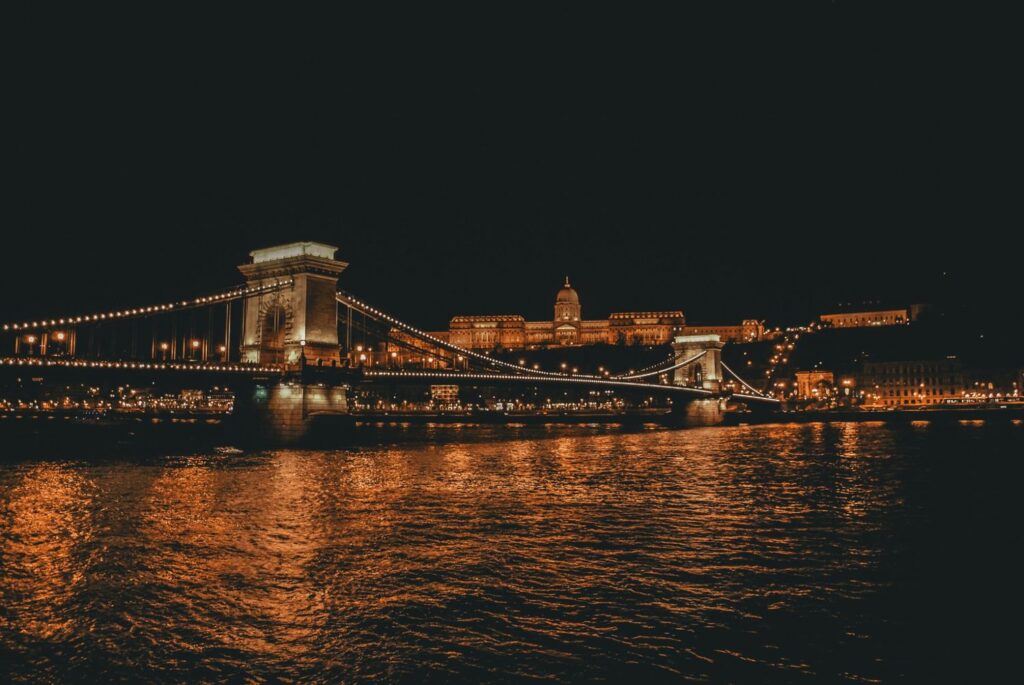
Photo by Dan Novac on Unsplash
The Chain Bridge (Széchenyi Lánchíd), Budapest’s first permanent bridge, connects the Buda and Pest sides of the city. Opened in 1849, it revolutionized travel across the Danube River and became a symbol of Hungary’s historical progress. Designed by William Tierney Clark, its iconic stone lion statues and iron chains have made it one of the most photographed landmarks in Budapest.
🌟 Highlights of The Chain Bridge
• Historical Significance
Built to unite Buda and Pest, the Chain Bridge was a key to the city’s development and modernization in the 19th century.
• Architectural Beauty
Designed in a neoclassical style, the bridge features towering stone lions at each end and iron chains that still support its weight today.
• Stunning Views
Walk across for panoramic views of Buda Castle, the Parliament, and the Danube River. The bridge is especially photogenic at sunrise or sunset when the city is bathed in golden light.
• Cultural Significance
More than just a bridge, it symbolizes Hungary’s unity, progress, and architectural achievements.
🚶 How to Get There
• By Foot: Located near Váci Street, the Chain Bridge is a short walk from key attractions like St. Stephen’s Basilica and the Parliament.
• By Metro: The M2 (red line) has a stop at Deák Ferenc tér, a 5-minute walk from the bridge.
• By Tram/Bus: Tram 2 runs along the Danube, stopping near the Chain Bridge.
🕒 Visitor Information
• Opening Hours:
- Open 24 hours for pedestrians.
• Entry Fees: - Free to cross and explore the area.
• Estimated Duration: - A visit usually takes 15-30 minutes, depending on your interest in the views and photos.
💡 Travel Tips
• 🕰️ Best Time to Visit:
Early morning or late afternoon offers the best light for photos, while evenings provide beautiful illuminations.
• 📸 What to Bring:
Comfortable shoes and a camera for stunning photo opportunities.
• 🚶 Nearby Attractions:
- Buda Castle and Fishermen’s Bastion on the Buda side, or the Parliament Building and Danube Promenade on the Pest side.
The Chain Bridge is more than a bridge—it’s a historical and cultural landmark that connects Budapest’s past with its present. Whether you’re admiring the views, crossing it, or just soaking in the atmosphere, it’s an essential experience when visiting the city.
Danube River Cruise

The Danube River Cruise offers one of the most unforgettable ways to experience Budapest. Whether you’re looking for a romantic evening or a daytime sightseeing tour, cruising along the Danube provides stunning views of the city’s iconic landmarks. From the Buda Castle perched on the hill to the majestic Parliament Building across the river, the river cruise offers panoramic vistas that showcase Budapest’s beauty like never before. As the sun sets and the city lights begin to twinkle, a Danube river cruise becomes a magical experience.
🌟 Highlights of the Danube River Cruise
• 🏰 Iconic Landmarks
A cruise offers unbeatable views of Buda Castle, the Parliament Building, Fishermen’s Bastion, and the Chain Bridge, all beautifully illuminated at night.
• 🌅 Romantic Sunset Cruise
Evening cruises are especially magical as the city transforms into a sea of lights, creating a romantic ambiance perfect for couples or anyone wanting to see the city in a new light.
• 🛥️ Sightseeing Options
Whether you prefer a traditional boat, a luxury dinner cruise, or a party boat, there are plenty of options to suit every interest and budget.
• 🌉 Famous Bridges
The river cruise lets you experience Budapest’s famous bridges, such as the Chain Bridge, Liberty Bridge, and Margaret Bridge, from a unique perspective on the water.
🚶 How to Get There
• By Foot:
The Danube Promenade is the main riverfront path, and the docks for most river cruises are located near Vörösmarty Square or Batthyány tér.
• By Public Transport:
Metro stations like Deák Ferenc tér (M1, M2, M3) and Batthyány tér (M2) are a short walk from the embarkation points. Many cruises also depart from stops along the Danube.
🕒 Visitor Information
• Opening Hours:
- Cruises run daily, typically from 10:00 AM to 10:00 PM, with special evening cruises available.
• Entry Fees: - Prices vary depending on the type of cruise, ranging from €15 for basic sightseeing tours to €50–€100 for dinner or luxury cruises.
• Estimated Duration: - Most sightseeing cruises last around 1 to 1.5 hours, while dinner cruises usually run 2–3 hours.
💡 Travel Tips
• 🕰️ Best Time to Visit:
- Daytime cruises offer clear views of the city’s landmarks, while evening cruises are perfect for experiencing Budapest’s stunning night lights.
• 📸 What to Bring:
A camera for spectacular photo opportunities, and a light jacket if you’re taking an evening cruise.
• 🌞 What to Expect:
Be prepared for a relaxed, scenic experience. If you’re on a dinner cruise, enjoy the local Hungarian dishes and wines while you glide along the river
The Danube River Cruise is the perfect way to see Budapest from a completely different angle. Whether you’re there for the history, the views, or a romantic evening, the cruise gives you a front-row seat to some of the city’s most breathtaking landmarks. Don’t miss this iconic experience when visiting Budapest!
Heroes’ Square
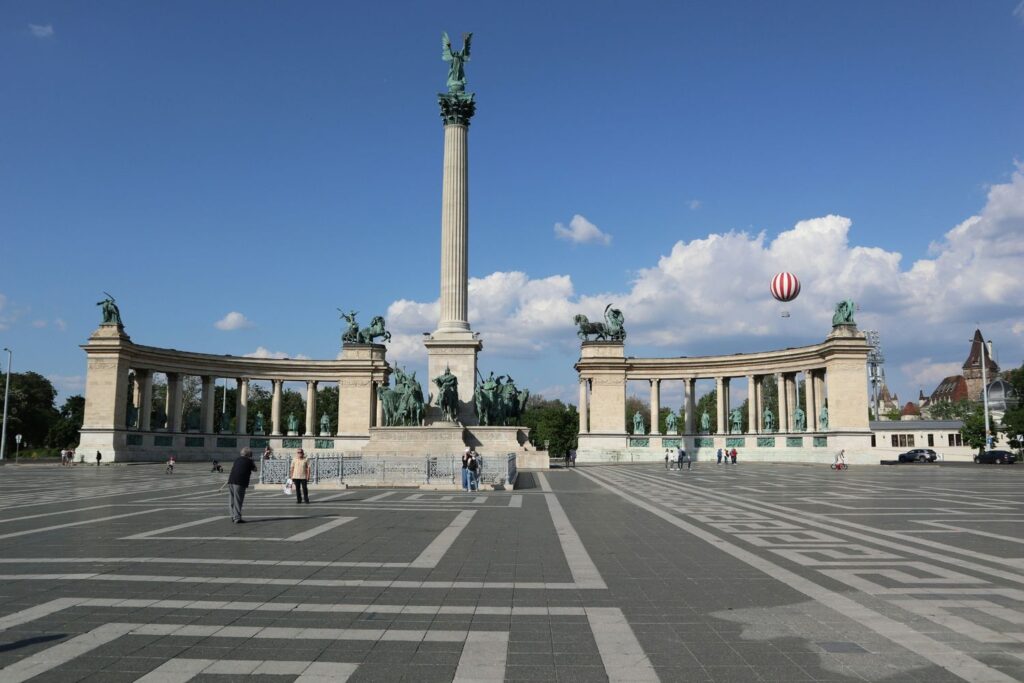
Heroes’ Square (Hősök tere) is one of Budapest’s most iconic and grandiose landmarks. Located at the end of Andrássy Avenue, this spacious square honors Hungary’s national history and heroes. The square’s centerpiece, the Millennium Monument, stands as a testament to the nation’s rich heritage and milestones, showcasing towering statues of Hungary’s most revered figures. With its expansive layout, dramatic statues, and surrounding museums, Heroes’ Square is not only an architectural marvel but also a place of cultural significance and pride for the Hungarian people.
🌟 Highlights of Heroes’ Square
• 🏛️ Millennium Monument
The Millennium Monument, erected in 1900 to commemorate Hungary’s 1,000th anniversary, is the centerpiece of Heroes’ Square. The monument features a column topped by Archangel Gabriel, holding a crown and a sword. Surrounding the column are statues of Hungarian kings and leaders, representing the country’s pivotal historical moments.
• 🗿 Statues of the Seven Chieftains
At the base of the monument, you’ll find statues of the Seven Chieftains of the Magyars, who are considered the founders of the Hungarian nation. These towering statues represent the first leaders who united the Magyar tribes in the 9th century.
• 🌿 City Park
Heroes’ Square is located next to Városliget (City Park), a lovely green space ideal for a relaxing stroll. The park offers several attractions, including the Széchenyi Thermal Baths, the Zoo, and Vajdahunyad Castle.
• 🏛️ Museum of Fine Arts & Palace of Art
The square is flanked by two major museums: the Museum of Fine Arts, housing a world-class art collection, and the Palace of Art (Műcsarnok), a prominent venue for contemporary art exhibitions.
🚶 How to Get There
• By Metro:
The M1 metro line (yellow line) has a stop at Hősök tere, making it the most convenient way to reach the square.
• By Tram/Bus:
Several tram and bus lines stop at or near Heroes’ Square, including tram lines 4 and 6, which run along Andrássy Avenue.
• By Foot:
If you’re near Andrássy Avenue, Heroes’ Square is a pleasant 10–15 minute walk from Deák Ferenc tér.
🕒 Visitor Information
• Opening Hours:
- The square itself is open 24/7, but surrounding attractions like the Museum of Fine Arts and Palace of Art have specific hours (typically 10:00 AM to 6:00 PM).
• Entry Fees: - Free entry to the square.
- Museums and other attractions around the square have their own admission fees.
• Estimated Duration: - Exploring Heroes’ Square usually takes 30 minutes to 1 hour, but if you plan to visit the museums or enjoy the nearby park, set aside 2–3 hours.
💡 Travel Tips
• 🕰️ Best Time to Visit:
- Early mornings or late afternoons are perfect for avoiding the crowds and catching the beautiful light. The square is especially stunning at sunset.
• 📸 What to Bring: - A camera to capture the magnificent statues and the grand layout of the square. If you’re visiting in summer, bring sunglasses and sunscreen for comfort.
• 🧳 Nearby Attractions: - After visiting the square, head over to the nearby City Park, explore the Széchenyi Thermal Baths, or walk towards Vajdahunyad Castle for a fairytale-like experience.
Heroes’ Square is a must-see for anyone interested in Hungary’s history and culture. With its monumental architecture, historical statues, and proximity to other cultural attractions, the square serves as a focal point for Budapest’s past, present, and future. Whether you’re strolling through the park, visiting the museums, or simply admiring the statues, Heroes’ Square offers a powerful glimpse into the soul of Budapest.
Gellért Hill and the Citadel
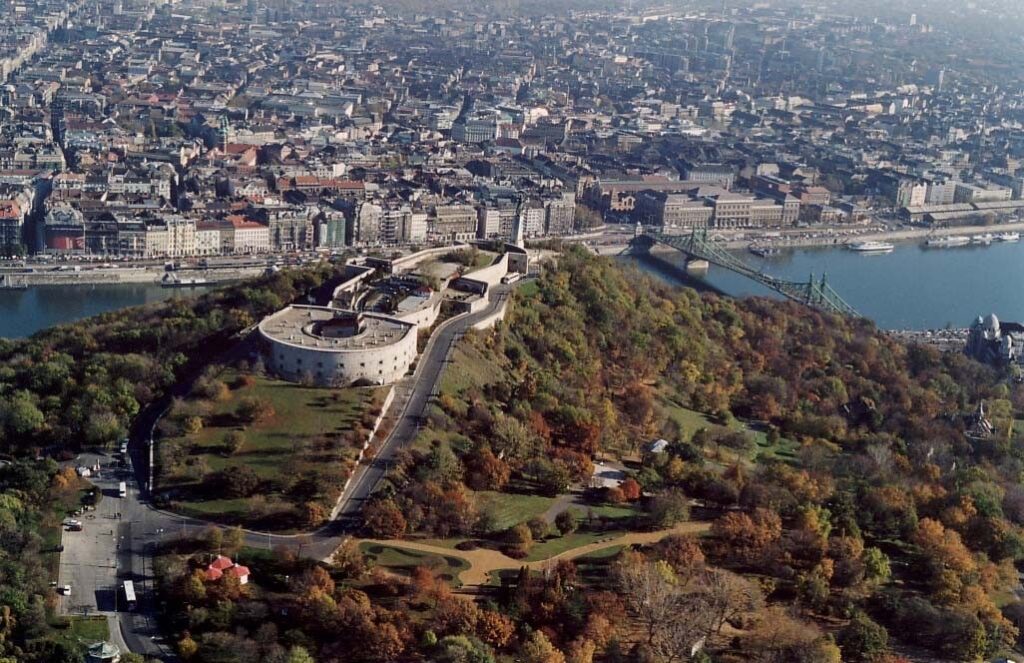
Gellért Hill is one of Budapest’s most iconic natural landmarks, offering spectacular panoramic views of the city. Rising 235 meters above the city, the hill is crowned by the Citadel, a historic fortress that has stood guard over the Danube for centuries. From here, visitors can admire stunning vistas of Budapest’s skyline, including the Parliament Building, Buda Castle, and the Chain Bridge. Beyond the breathtaking views, the hill and citadel have a rich history, from military significance to its role in shaping the city’s defense during various periods.
🌟 Highlights of Gellért Hill and the Citadel
• 🏰 The Citadel – A Historic Fortress:
The Citadel was built in 1851 by the Habsburgs to suppress potential uprisings and control the city. Its imposing walls and statue of Liberty at the summit are a reminder of Budapest’s complex history. The citadel itself is a fascinating historical site, and its strategic position offers the best panoramic views in the city.
• 🌇 Panoramic Views – Budapest’s Best Vantage Point:
The top of Gellért Hill provides sweeping views of Budapest, including Buda Castle, Fishermen’s Bastion, the Danube, and the Parliament Building. It’s the perfect spot for sunset photography and offers a unique perspective of the city.
• 🗿 Statue of Liberty – Symbol of Freedom:
At the top of the hill stands the Statue of Liberty, a 14-meter-high monument erected in 1947 in memory of those who sacrificed their lives for the liberation of Hungary during World War II. The statue’s outstretched arm and palm leaf symbolize peace and freedom.
• 🌿 Beautiful Green Space – A Tranquil Escape:
While the hill itself is steep, there are various paths and scenic walking trails that make it accessible to those seeking a peaceful walk among lush greenery. The area is also home to Gellért Hill Cave, a small church built into the hillside.
🚶 How to Get There
• By Foot:
The climb to the top of Gellért Hill can be done on foot via various pathways starting from Gellért Square or the Citadel Path. The walk is steep but rewarding, taking about 15–30 minutes to reach the top.
• By Public Transport:
The Gellért Hill area is well-connected by bus and tram. You can take Tram 47 or 48 to Gellért tér, which is a short walk to the foot of the hill. From there, you can either take the funicular or walk up to the Citadel.
• By Taxi:
If you prefer not to hike, taxis or ride-sharing services are available to take you directly to the top.
🕒 Visitor Information
• Opening Hours:
- The hill and the Citadel are open 24/7 for visitors.
- The Statue of Liberty and surrounding area can be enjoyed at any time. However, if you wish to visit the Citadel or other buildings, the opening hours may vary.
• Entry Fees: - Free access to the hill, statues, and walking trails.
- Some areas like the Gellért Hill Cave Church may have small entrance fees for entry.
• Estimated Duration: - A visit to Gellért Hill and the Citadel typically lasts 1–2 hours, depending on how long you spend walking around, taking photos, and enjoying the views.
💡 Travel Tips
• 🕰️ Best Time to Visit:
- Sunset is one of the best times to visit, as the views of the city are simply breathtaking. Morning visits offer a quieter, peaceful experience.
• 📸 What to Bring: - A camera to capture the magnificent vistas, comfortable shoes for the walk, and water for the hike.
• 🧭 Hiking: - For those looking for a bit of exercise, walking up Gellért Hill is a fun and rewarding experience. The trails are well-marked and offer different routes to the top, some more challenging than others.
Gellért Hill and the Citadel offer one of the best panoramic views of Budapest and are steeped in history and natural beauty. Whether you’re hiking up to the top for breathtaking photos, admiring the Statue of Liberty, or exploring the Citadel itself, this iconic hill is an essential part of any visit to Budapest.
Ruin Bars
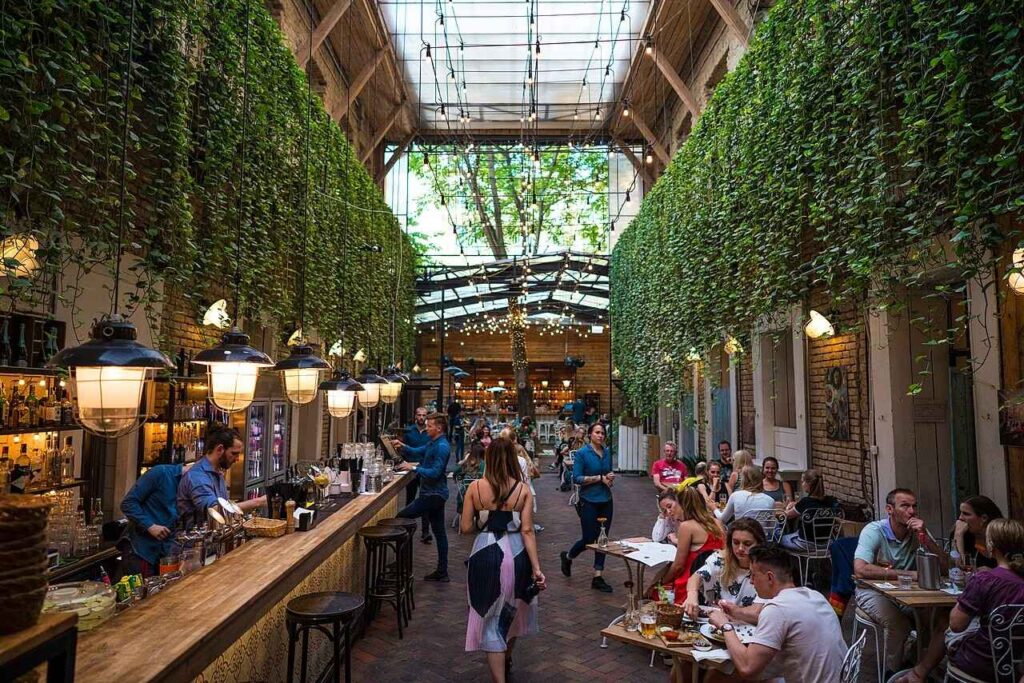
Budapest’s ruin bars are one of the city’s most distinctive and exciting experiences. These eclectic, quirky bars are set in abandoned buildings, mostly in the historic Jewish Quarter, and have become a popular hub for both locals and tourists. The charm of ruin bars lies in their unconventional decor, often combining vintage furniture, mismatched art, and playful atmospheres. Many of these bars have sprung up in buildings that were left to decay after World War II, making them a perfect blend of Budapest’s gritty past and vibrant present.
🌟 Highlights of Ruin Bars
• 🏚️ Unique Atmosphere
The bars are housed in derelict buildings, with walls covered in graffiti, random collections of antiques, mismatched furniture, and funky decorations. The combination of decay and creativity creates a cozy yet lively vibe.
• 🍸 Diverse Drinks
Whether you’re into classic cocktails, local Hungarian pálinka, or craft beers, ruin bars have something to offer. Many bars also feature affordable drink specials, making them a great choice for those on a budget.
• 🎶 Live Music & DJs
Ruin bars are often hubs for live music, ranging from local bands to DJ sets. The atmosphere is always energetic, with a mix of visitors enjoying the beats while sipping drinks.
• 🌿 Hidden Gardens & Courtyards
Some ruin bars feature outdoor spaces like gardens or courtyards, creating a laid-back setting for a drink under the stars. These areas are perfect for those looking for a more relaxed atmosphere away from the crowd.
🚶 How to Get There
• By Foot:
Most ruin bars are clustered in the Jewish Quarter, around Kazinczy Street, and can be reached easily by foot from nearby neighborhoods like District VII and Deák Ferenc tér.
• By Metro:
The M2 metro line (red line) stops at Deák Ferenc tér or Astoria, which are both a short walk from the heart of the ruin bar district.
• By Public Transport:
Several buses and trams also run along Kazinczy Street or near Szimpla Kert (one of the most famous ruin bars), making it easy to get around.
🕒 Visitor Information
• Opening Hours:
- Most ruin bars are open late into the night, typically from 7:00 PM to 2:00 AM, with some staying open even later, especially on weekends.
• Entry Fees: - Entry is usually free at most ruin bars, though some may charge a small cover fee for special events or parties.
• Estimated Duration: - Visiting a ruin bar can take anywhere from 1 to 3 hours depending on how long you wish to relax, explore, and enjoy the live entertainment or drinks.
💡 Travel Tips
• 🕰️ Best Time to Visit:
- Evenings and late nights are the best times to experience the full energy of ruin bars. Weekdays tend to be quieter, while weekends are packed with locals and tourists alike.
• 📸 What to Bring: - Your camera for the amazing decor, and some cash in case you need to pay for drinks or events. Many ruin bars don’t accept cards, so it’s good to have local currency on hand.
• 🎉 Special Events: - Keep an eye on special events or themed nights at ruin bars, such as karaoke, quiz nights, or film screenings, for a unique twist on your night out.
After a fun night out at a ruin bar, you can visit these nearby spots:
• Szimpla Kert: The most famous ruin bar, with an amazing interior and outdoor garden.
• The Jewish Quarter: Explore the Dohány Street Synagogue, the largest synagogue in Europe, and other cultural landmarks nearby.
• Street Art: Discover Budapest’s thriving street art scene, especially around the Kazinczy and Gozsdu Courtyard areas.
Ruin bars are a must-visit for anyone wanting to experience Budapest’s alternative nightlife. These eclectic bars combine history, creativity, and a fun atmosphere, making them a one-of-a-kind experience. Whether you’re enjoying a drink, taking in the atmosphere, or dancing to live music, ruin bars offer an unforgettable way to immerse yourself in the city’s dynamic culture.
Best Time to Visit Budapest
Spring (March to May)
Spring is one of the best times to visit Budapest. The weather is mild, the flowers are in bloom, and the city feels alive with festivals and outdoor events. Plus, you’ll avoid the summer crowds, making it perfect for sightseeing.
Summer (June to August)
Summer brings warm weather, longer days, and plenty of festivals. While the city is bustling with tourists, it’s also the time for outdoor concerts, boat parties on the Danube, and exploring the city’s open-air terraces. However, be prepared for higher hotel rates and crowded attractions.
Autumn (September to November)
Autumn is another excellent time to visit Budapest, with cooler temperatures and fewer tourists. The fall foliage adds a beautiful touch to the city’s parks and the views from Buda Castle. It’s also harvest season, so you can enjoy Hungary’s wines and seasonal dishes.
Winter (December to February)
Winter in Budapest can be cold, but it’s also magical. The city is beautifully decorated for the holidays, and you can enjoy Christmas markets, warm thermal baths, and cozy cafés. It’s the perfect time for those seeking a quieter, more intimate experience of Budapest.
Insider Tips for Visiting Budapest
- Use public transport: Budapest’s metro, trams, and buses are easy to navigate and affordable.
- Buy skip-the-line tickets for popular attractions like Széchenyi Thermal Baths and the Parliament Building to avoid long waits.
- Bring comfortable shoes: Budapest is best explored on foot, especially when wandering through the historic districts.
- Sample Hungarian pastries: Don’t leave without trying a slice of Dobos Torte or a warm chimney cake.
- Take a night walk: Budapest is beautiful at night, with many landmarks, like the Chain Bridge and Buda Castle, lit up and reflecting in the Danube.
Final Thoughts
Budapest is a city that blends history, culture, and natural beauty into an unforgettable experience. Whether you’re soaking in the thermal baths, marveling at architectural masterpieces, or enjoying the local food scene, Budapest offers a perfect balance of tradition and modernity. Time your visit to match your preferences and enjoy the rich history and vibrant culture this captivating city has to offer.

I’m Shreyash Mhashilkar — a full-stack developer by profession, and a passionate explorer of the future at heart.
With a strong foundation in both front-end and back-end , I spend my days building websites and applications that are not just functional, but scalable, intuitive, and user-focused.

